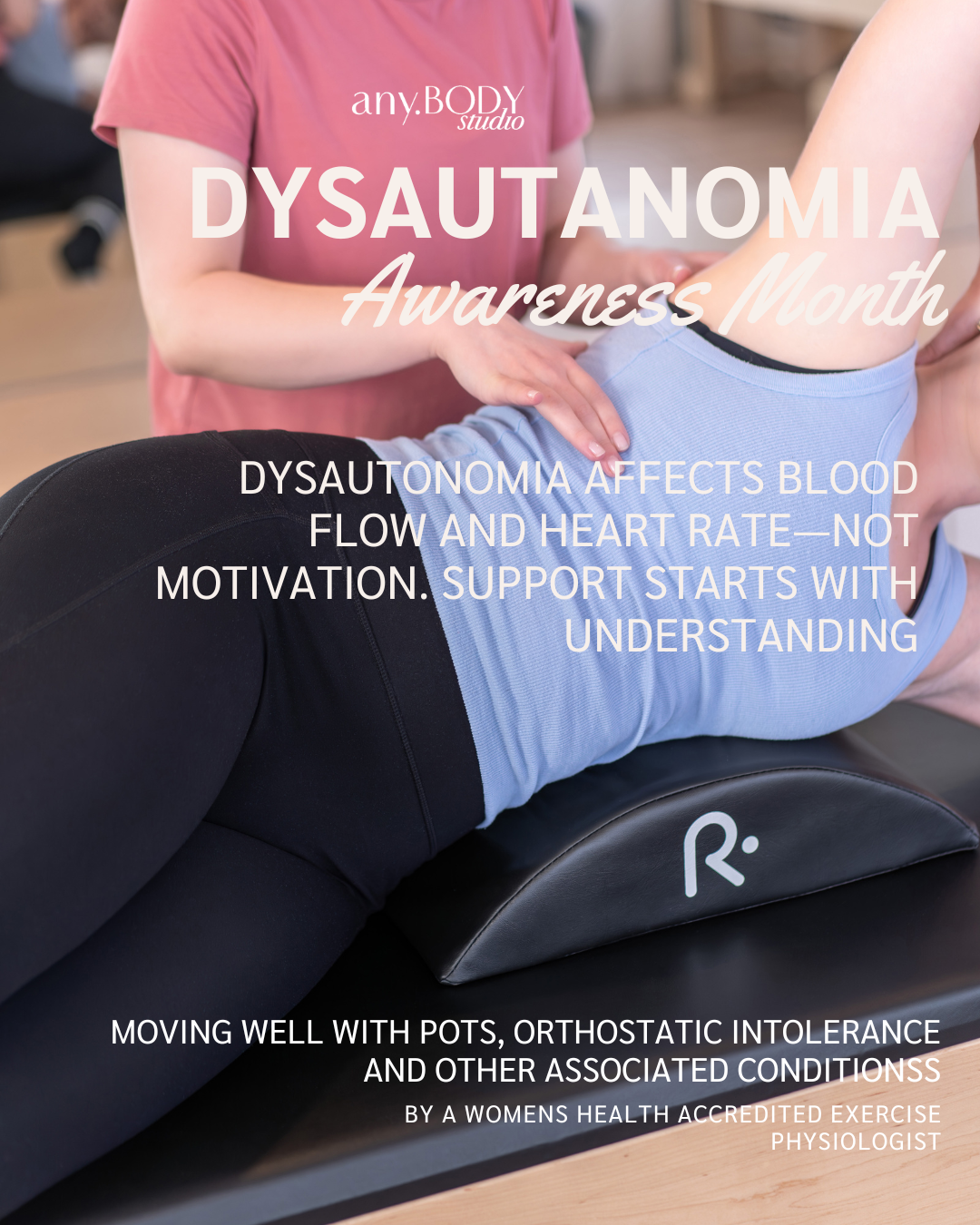Moving well with POTS, orthostatic intolerance and other conditions
First, a gentle note: If you’re living with dysautonomia, you’re not “starting from zero.” You’ve already been navigating a lot — symptoms, uncertainty, and the invisible work of getting through each day. Movement can feel intimidating, hopeful, or both. We see you.
Dysautonomia describes changes in the autonomic nervous system (your body’s autopilot for heart rate, blood pressure, temperature, digestion and more). The most recognised subtype we see is postural orthostatic tachycardia syndrome (POTS). With care, pacing and collaboration, movement can become a tool for steadier days — not another thing to push through.
At any.BODY, we move at your speed. We co-create plans, celebrate tiny wins, and build trust with your body again — one position, one breath, one choice at a time.
Important: This article is educational and not medical advice. Please work with your GP/specialist and a qualified EP, especially if you’ve had syncope, new chest pain, rapid symptom changes, or co‑occurring conditions (e.g., ME/CFS, EDS, MCAS).
Understanding dysautonomia in movement contexts
When the ANS is dysregulated, simply standing can trigger tachycardia, blood pooling in the lower body, light‑headedness, fatigue, brain fog, temperature sensitivity and GI upset. The right type of movement with support can help by:
improving venous return (muscle pump, especially calves/quads/glutes),
supporting blood volume and peripheral conditioning,
enhancing baroreflex tolerance to posture change,
improving breathing patterns and CO₂ tolerance, and
building confidence with graded exposure to upright positions.
Co‑conditions (EDS/hypermobility, MCAS, migraine, ME/CFS) may change tolerance and recovery windows. We individualise dosage accordingly.
Living with dysautonomia can feel like your body’s “autopilot” glitches at random. Standing up can feel like sprinting; heat turns errands into events; a shower, the grocery line, or a meeting can tip you into dizziness, racing heart, breathlessness, or brain fog. Plans revolve around chairs, cool air, water bottles, and exits. Some days you can do more, other days you can’t—and that unpredictability is exhausting. It’s common to feel anxious, frustrated, or grieving the way things used to be. You’re not weak or “overreacting”—your nervous system is working overtime. With a paced, symptom-aware approach, small wins add up: steadier moments, more confidence, and a little more life in the things you love. We see you, we believe you, and we’ll meet you where you are.
Principles we use at any.BODY
Start where your body feels safest. We begin horizontal and earn gravity gradually. Your comfort matters more than timelines.
Capacity over intensity. Consistent, bite‑sized wins beat boom‑and‑bust. Rest is part of training.
Breath before load. We practice easy, lateral rib expansion and relaxed exhales. No breath‑holding required.
Intervals & isometrics to build trust. Short bouts with generous rest create positive experiences.
Thermo‑aware spaces. Fans, cool towels, and flexible pacing — because heat can be a trigger.
Compression & calves. Practical tools to support blood return and steadier upright time.
Shared language & choice. You always have options and an exit path to supine. We’ll check in often, together.
Working with PEM (post‑exertional malaise)
If you also experience PEM:
We will keep sessions shorter (20-30 min) and alternate movement days with recovery days.
Track 24–72 hr response; adjust by reducing total volume by 10–30% when flares occur.
Consider intervals with longer rests and isometrics instead of continued movement.
What Week 1 with any.BODY can look like (education‑first)
Initial consultation (in‑studio or telehealth, 45–60 min)
A compassionate, collaborative history — your story guides the plan.
Gentle education: how dysautonomia interacts with movement, why we start horizontal → vertical, and how breath, calves and quads support regulation
Pre‑session checklist
☐ Compression on
☐ Hydrated; electrolyte ready
☐ Cool environment/fan
☐ Light snack if needed
☐ Exit plan: mat available to lie down; staff know your stop signs, we are awere of your red alerts
How we support you at any.BODY
1:1 Exercise Physiology consults that prioritise feeling safe and understood. We map your position ladder & symptom‑aware plan together.
Small‑group clinical classes (1:3) with flexible pacing, seated options and built‑in rest blocks.
Mindful/Gentle Reformer Pilates tailored for venous return (footwork, calves, glutes) and breath mechanics.
Education & pacing coaching to step out of boom‑and‑bust with confidence.
Telehealth sessions when in‑studio isn’t feasible (flare days, transport, heat).
Care‑team collaboration with your GP/cardiologist and allied health.
We’ll modify and tailor your plan as we go. Progress is rarely linear — variability is normal, and you won’t have to navigate it alone.











